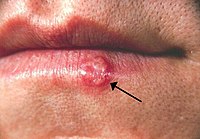
Photo from wikipedia
Background/aims To examine the incidence, causative microorganisms and in vitro antimicrobial susceptibility and resistance profiles of infectious keratitis (IK) in Nottingham, UK. Methods A retrospective study of all patients who… Click to show full abstract
Background/aims To examine the incidence, causative microorganisms and in vitro antimicrobial susceptibility and resistance profiles of infectious keratitis (IK) in Nottingham, UK. Methods A retrospective study of all patients who were diagnosed with IK and underwent corneal scraping between July 2007 and October 2019 (a 12-year period) at a UK tertiary referral centre. Relevant data, including demographic factors, microbiological profiles and in vitro antibiotic susceptibility of IK, were analysed. Results The estimated incidence of IK was 34.7 per 100 000 people/year. Of the 1333 corneal scrapes, 502 (37.7%) were culture-positive and 572 causative microorganisms were identified. Sixty (4.5%) cases were of polymicrobial origin (caused by ≥2 different microorganisms). Gram-positive bacteria (308, 53.8%) were most commonly isolated, followed by Gram-negative bacteria (223, 39.0%), acanthamoeba (24, 4.2%) and fungi (17, 3.0%). Pseudomonas aeruginosa (135, 23.6%) was the single most common organism isolated. There was a significant increase in Moraxella spp (p<0.001) and significant decrease in Klebsiella spp (p=0.004) over time. The in vitro susceptibilities of Gram-positive and Gram-negative bacteria to cephalosporin, fluoroquinolone and aminoglycoside were 100.0% and 81.3%, 91.9% and 98.1%, and 95.2% and 98.3%, respectively. An increase in resistance against penicillin was observed in Gram-positive (from 3.5% to 12.7%; p=0.005) and Gram-negative bacteria (from 52.6% to 65.4%; p=0.22). Conclusion IK represents a relatively common and persistent burden in the UK and the reported incidence is likely underestimated. Current broad-spectrum antimicrobial treatment provides a good coverage for IK, although challenged by some level of antimicrobial resistance and polymicrobial infection.
Journal Title: British Journal of Ophthalmology
Year Published: 2020
Link to full text (if available)
Share on Social Media: Sign Up to like & get
recommendations!